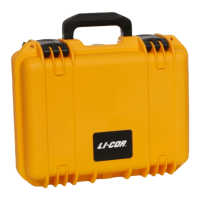6
Clean the parts.
Retrieve an optical path swab from the accessories kit. Dip one end into a 50:50 eth-
anol-water mixture (mild dish washing soap and water will work too) and carefully
swab both ends of the optical path. Dip a Source/Detector swab into the solution
and then swab around the source and detector to remove any residue.
Caution: Do not use abrasive cleansers. Abrasive cleaners can irreparably damage
the gold plating on the optical path, source, or detector.
7
Inspect the hose barbs and tubing.
If the tubes are dirty or damaged, replace them with new tubes (available from
LI-COR, part number 6580-041). Carefully remove them from the hose barbs. If the
tubes are in good condition and clean, you may be able to reuse them. If the hose
barbs are dirty, remove them and clean them with rubbing alcohol or soapy water.
Use caution: Do not scratch the hose barbs because scratches may cause leaks.
8
Inspect the O-rings.
If they are smashed flat or damaged in any way, replace them with new O-rings (part
number 192-00226) from the accessories kit.
9
Let the optical bench components dry.
10
Reassemble the optical bench.
Attach the source and detector. The orientation of the optical path cylinder is unim-
portant — either end can be inserted into the source and detector housing. Tighten
each of the screws snugly.
11
Place the optical bench in the foam, plug in the source and detector connectors, and re-assemble
the case.
Be sure the foam insulation on the top cover is positioned over the optical bench. It
is required for thermal stability.
12
Perform a zero and span calibration. See User calibration on page5-1.
Section 5. Maintenance
5-5Cleaning the optical bench

